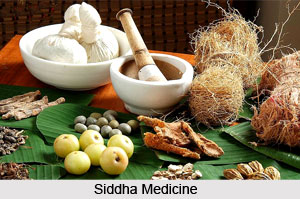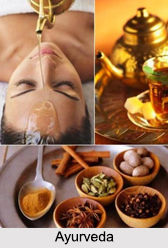Shirodhara is the most commonly employed therapy in In Ayurveda, a variety of therapies are used to enhance purification and elimination during the process of Pancha Karma. These procedures also rejuvenate and replenish specific zones of the body. Such types of adjunctive procedures of Pancha Karma generally employ particular form of snehana and swedana. They address the functions of any particular dosha. These procedures are also used outside Pancha Karma simply by themselves. Or they can be used outside Pancha Karma in conjunction with other treatments in order to achieve palliative or nutritive effect either on the whole body or a localized area.
 Shirodhara
Shirodhara
Pancha Karma. Shiro literally means `head` and dhara means `the dripping of oil like a thread`. The treatment of shirodhara drips warm oil in a steady stream on the forehead, particularly on the brow in the region between the eyes. It calms vata and that is why it is often added to the Pancha Karma regimen. Shirodhara pacifies prana vayu in particular and also soothes the central nervous system. This procedure in Pancha Karma actually quiets both the senses and the mind that allows the body`s natural healing mechanisms for releasing stress from the nervous system. It in turn, improves mental clarity and comprehension. Shirodhara in Pancha Karma is usually given for 20 minutes and three to four times during a seven day treatment period. It generally uses oils that are made with special herbs, which calm and nourish the nervous system and open the prana shrotas in the head. In this therapy, the oil flows in a thin stream from a copper vessel hung approximately 6-8 inches above the forehead of the patient.
Pishinchhali
This pre-procedure of Pancha Karma is more popular in southern India as there is a predominance of vata-aggravating weather. Pishin means `squeezing` and chhali means `vigorous movement`. Huge quantity of oils are squeezed or poured over the body while massaging it vigorously with a rounded mass of rice wrapped in a cloth. This drives the oil powerfully through the pores of the skin so that it can penetrate into the deep tissues. The pishinchhali treatment is both invigorating and pleasing. The most important function of this therapy is that it pacifies vata. It also stimulates the marma points and creates harmony between the five sub-doshas of vata. This treatment of Pancha Karma works in a specific way to eradicate toxins from the joints and improve their mobility. Moreover, it provides a powerful tool for reducing muscle spasm and degenerative muscle diseases. If it is administered several times then it becomes truly effective. It is structured as its own separate treatment protocol.
 Pinda Swedana
Pinda Swedana
Pinda literally means a soft rounded mass or bolus and swedana means heat. In this Panchakarma therapy, hot bolus of cooked rice (prepared with using vata pacifying herbs) is drenched in an herbal milk decoction of nutritive herbs. During the treatment, the hot bolus is rubbed dynamically over the entire body with a special focus on the joints and muscle tissues. This procedure usually follows snehana. This particular swedana improves muscle tone and nurtures mamsa dhatu and vata. It is helpful for the treatment of degenerative muscle diseases. This therapy is used in conjunction with Pancha Karma. This therapy is performed over a period of time.
There are several other types of swedana that are used as adjunct therapies in Pancha Karma. Each of the swedana therapies has its own specific purpose. As an instance, tapa swedana also known as ruksha swedana includes application of dry heat like sauna or hot sand fomentation. This therapy is prescribed for reducing the inflammation and congestion in the joints. Next heat therapy used in Pancha Karma is upanaha swedana that uses hot and herbal poultices prepared with oil and water. They can be applied in varying degrees of wetness. This therapy is particularly effective in conditions where the joints are painful and inflamed. The balanced combination of heat, oil and herbs reduces pain and restores mobility to the joints. Drava swedana uses herbal decoctions in hot water. The herbs possess penetrating qualities which enhance the heating effect of the treatment. Lastly, ushma swedana uses steam that is generally applied to the whole body and particularly to the joints.
It is mentioned in Ayurveda that these adjunctive procedures of Pancha Karma have beneficial effect on the entire circulatory system.




















